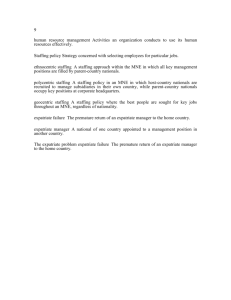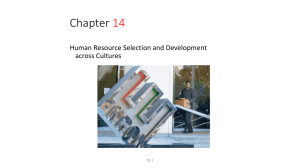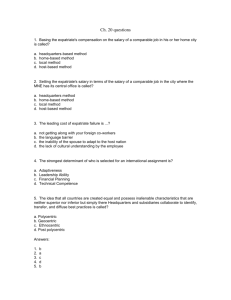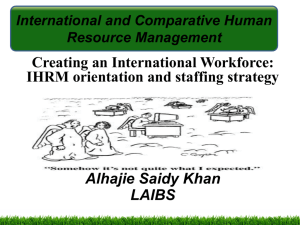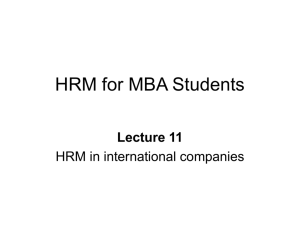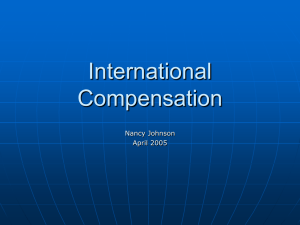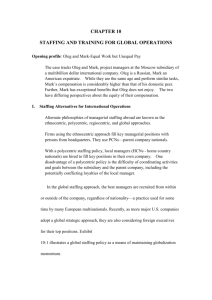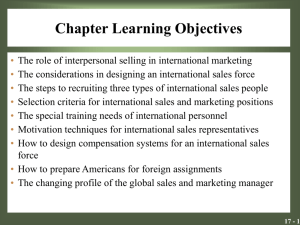Global Human Resource Management
advertisement
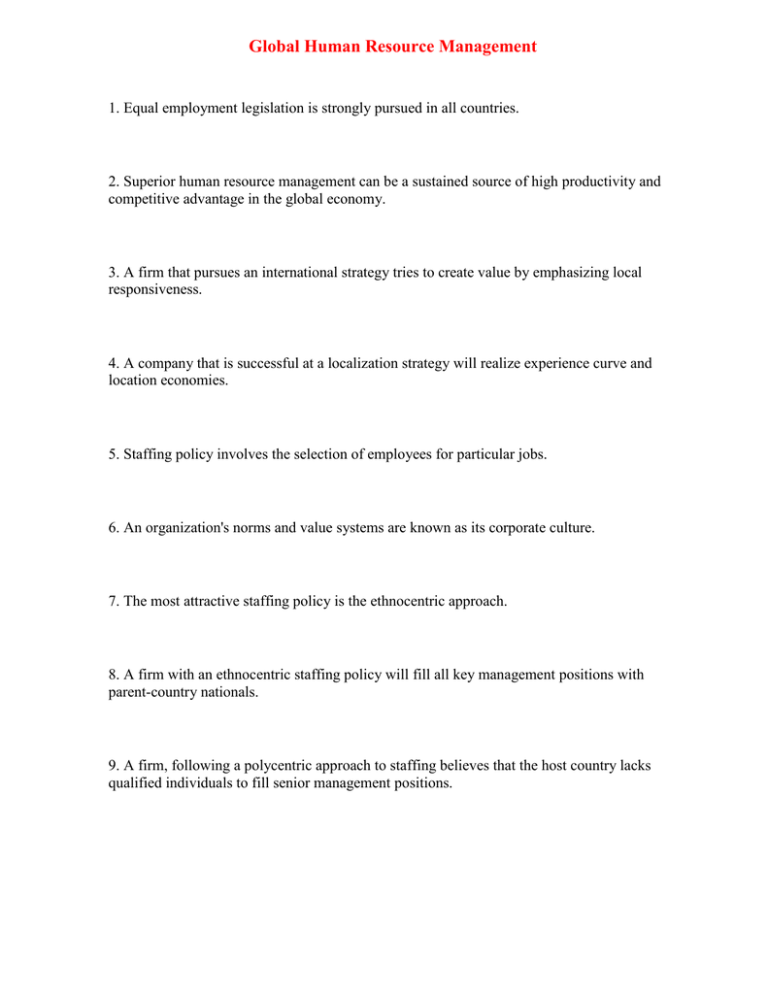
Global Human Resource Management 1. Equal employment legislation is strongly pursued in all countries. 2. Superior human resource management can be a sustained source of high productivity and competitive advantage in the global economy. 3. A firm that pursues an international strategy tries to create value by emphasizing local responsiveness. 4. A company that is successful at a localization strategy will realize experience curve and location economies. 5. Staffing policy involves the selection of employees for particular jobs. 6. An organization's norms and value systems are known as its corporate culture. 7. The most attractive staffing policy is the ethnocentric approach. 8. A firm with an ethnocentric staffing policy will fill all key management positions with parent-country nationals. 9. A firm, following a polycentric approach to staffing believes that the host country lacks qualified individuals to fill senior management positions. 10. There is an increasing trend towards an ethnocentric staffing policy. 11. A firm that adopts a polycentric approach to staffing is likely to suffer from cultural myopia. 12. Firms may choose an ethnocentric approach to staffing as opposed to a polycentric approach because of the cost savings it promotes. 13. A geocentric staffing policy seeks the best people for key jobs throughout the organization, regardless of nationality. 14. Many firms adopt a geocentric policy toward staffing because it is a relatively inexpensive staffing policy. 15. A citizen of Japan who moves to the United States to work at Microsoft would be classified as an inpatriate. 16. Research suggests that only between 6 and 10 percent of all American employees sent abroad to developed nations return from their assignments early. 17. Research into expatriate failure revealed that consistently, one of the reasons for the premature return of employees for U.S. multinationals was the inability of the spouse to adjust. 18. For European firms, the top reason for expatriate failure was the inability of the manager to cope with larger overseas responsibilities. 19. Domestic performance and overseas performance potential are not the same thing. 20. An expatriate needs to have language fluency to show willingness to communicate. 21. The ability to understand why people of other countries behave the way they do is perceptual ability. 22. A manager who has a global mindset will adapt to a culture that is very different from his/her own. 23. Research by International Orientation Resources suggests that 90 percent of the time employees were selected on the basis of their cross-cultural fluency. 24. Historically, most international businesses have been more concerned with management development than with training. 25. Expatriate failure can be reduced through cultural training, language training and practical training. 26. It is not possible to conduct business nearly all over the world using only English. 27. In many cases, firms fail to plan for an expatriate's repatriation. 28. Bringing managers together in one location for extended periods and rotating them through different jobs in several countries helps the firm build a formal management network. 29. Intentional bias makes it difficult to evaluate the performance of expatriate managers objectively. 30. Many expatriate managers believe that headquarters management evaluates them unfairly and does not fully appreciate the value of their skills and experience. 31. Most expatriates believe that more weight should be given to an on-site manager's appraisal than to an off-site manager's appraisal. 32. In ethnocentric firms, the lack of managers' mobility among national operations implies that pay can and should be kept country-specific. 33. Base pay in most firms is set with regard to global market conditions. 34. The most common approach to expatriate pay is the balance sheet approach. 35. An expatriate's base salary normally varies from the base salary for a similar position in the home country. 36. A foreign service premium is offered as an inducement to accept foreign postings. 37. Labor unions generally try to get better working conditions for their members through collective agreement with management. 38. The short-term goal of ITSs was to be able to bargain transnationally with multinational firms. 39. There is now a trend toward greater decentralized control. 40. The general rise in competitive pressure in industry after industry has made it more important for firms to control their costs. Multiple Choice Questions 41. _____ refers to the activities an organization carries out to utilize its human resources effectively. A. Organizational behavior B. Strategic management C. Human resource management D. Organizational policy 42. A citizen of one country who is working abroad in one of the firm's subsidiaries is known as a(n) A. Subsidiary manager B. Foreign manager C. International manager D. Inpatriate manager 43. _____ is/are the linchpin of a firm's organization architecture. A. People B. Strategy C. Business processes D. Organizational structure 44. A firm following a(n) _____ strategy will try to create value by realizing experience curve and location economies. A. Localization B. Domestic focused C. Global standardization D. International 45. Firms should build a strong corporate culture and an informal management network for transmitting information and knowledge within the organization if they are pursuing a(n) A. Transnational strategy B. Localization strategy C. Global standardization strategy D. International strategy 46. Which of the following is mainly concerned with the selection of employees for particular jobs? A. Retention policy B. Staffing policy C. Incentive policy D. Appraisal policy 47. An organization's norms and value systems are known as A. Human resource management B. Corporate governance C. Business ethics D. Corporate culture 48. An ethnocentric staffing policy is one in which A. All key management positions are filled by parent company nationals B. Host-country nationals are recruited to manage subsidiaries while parent-company nationals occupy key positions at corporate headquarters C. The best people, regardless of nationality, are recruited to fill key positions throughout the organization D. Corporate bureaucracy overwhelms the system leaving key positions to be filled in a haphazard manner 49. This policy for staffing involves filling all key management positions with parent company nationals. A. Polycentric B. Regiocentric C. Ethnocentric D. Geocentric 50. Many Japanese firms prefer expatriate Japanese managers to head their foreign operations because these managers have been socialized into the firm's culture while employed in Japan. This implies that A. The firm may believe that such managers cannot progress beyond senior positions in their parent company B. The firm may see an ethnocentric staffing policy as the best way to maintain a unified corporate culture C. The firm is trying to create value by transferring core competencies to a foreign operation D. The firm requires host-country nationals to be recruited to manage subsidiaries 51. A firm that is trying to maintain a unified corporate culture will pursue a(n) A. Geocentric staffing policy B. Regiocentric staffing policy C. Ethnocentric staffing policy D. Polycentric staffing policy 52. If a firm is trying to create value by transferring core competencies to a foreign operation and believes that the best way to do accomplish this goal is to transfer parent-country nationals who have knowledge of that competency to the foreign operation, it is pursuing a(n) A. Ethnocentric strategy B. Transnational strategy C. Localization strategy D. Global standardization strategy 53. A polycentric approach to staffing is one in which A. All key management positions are filled by parent company nationals B. Host-country nationals are recruited to manage subsidiaries while parent-company nationals occupy key positions at corporate headquarters C. The best people, regardless of nationality, are recruited to fill key positions throughout the organization D. Corporate bureaucracy overwhelms the system leaving key positions to be filled in a haphazard manner 54. The use of a(n) _____ staffing policy is declining in most countries because of the limited opportunities it provides for host-country nationals and also because it can lead to cultural myopia. A. Regiocentric B. Geocentric C. Polycentric D. Ethnocentric 55. Cultural myopia refers to a firm's failure to A. Adapt to certain ethnocentric cultures through the expatriate B. Help female Western managers in many cultures which are extremely male-dominated C. Understand host-country cultural differences that require different approaches to marketing and management D. Identify countries which are much tougher postings than others because their cultures are more unfamiliar and uncomfortable 56. What is the reason for a decline in pursuing an ethnocentric staffing policy in most international businesses? A. It is expensive to implement B. It limits advancement opportunities for host-country nationals C. A gap can arise between host-country managers and parent-country managers D. The lack of management transfers from home to host countries 57. If a company recruits host-country nationals to manage subsidiaries while parent-country nationals occupy key positions at corporate headquarters, the firm is following a(n) A. Ethnocentric staffing policy B. Regiocentric staffing policy C. Polycentric staffing policy D. Geocentric staffing policy 58. What is the advantage of adopting a polycentric approach? A. It is inexpensive to implement and reduces the costs of value creation B. Host-country nationals have opportunities to gain experience outside their own country C. It enables the firm to make the best use of its human resources D. It enables the firm to build a cadre of international executives who feel at home working in a number of cultures 59. What is the major drawback with a polycentric approach? A. Training and relocation costs increase when transferring managers from country to country B. It can lead to cultural myopia C. It limits advancement opportunities for host-country nationals D. The gap that can form between host-country managers and parent-country managers 60. A polycentric approach may be effective for firms pursuing a(n) A. International strategy B. Localization strategy C. Transnational strategy D. Global standardization strategy 61. Food and detergents giant Unilever had foreign subsidiaries that had evolved into quasi-autonomous operations, each with its own strong national identity. They objected strenuously to corporate headquarters' attempts to limit their autonomy. Thus, Unilever found it very difficult to shift from a strategic posture that emphasized localization to a transnational posture because of A. Difficulty in achieving the coordination required to pursue experience curve and location economies B. The difficulty in achieving coordination required to transfer core competencies C. The federation that resulted from a polycentric approach D. Expensive implementation and increased costs of value creation 62. What is the most important advantage of using a geocentric staffing policy? A. It enables the firm to build a cadre of international executives who feel at home working in a number of cultures B. It may be less expensive to implement than other policies, reducing the costs of value creation C. The higher pay managers on an international fast track enjoy is a source of inspiration within a firm D. It involves no costs of training and relocation when transferring managers from country to country 63. Which of the following is a problem that limits a firm's ability to pursue a geocentric policy? A. The lack of management transfers from home to host countries and vice versa, can lead to a lack of integration between corporate headquarters and foreign subsidiaries B. The higher pay managers on an international fast track enjoy may be a source of resentment within a firm C. The firm fails to understand host-country cultural differences that require different approaches to marketing and management D. It limits advancement opportunities for host-country nationals 64. A geocentric approach to staffing is one in which A. All key management positions are filled by parent company nationals B. Host-country nationals are recruited to manage subsidiaries while parent-country nationals occupy key positions at corporate headquarters C. The best people, regardless of nationality, are recruited to fill key positions throughout the organization D. Corporate bureaucracy overwhelms the system leaving key positions to be filled in a haphazard manner 65. An ethnocentric approach to staffing is appropriate for firms that are pursuing a(n) A. International strategy B. Localization strategy C. Global standardization strategy D. Transnational strategy 66. What is the advantage of using an ethnocentric staffing approach? A. Uses human resources efficiently B. Alleviates cultural myopia C. Inexpensive to implement D. Helps transfer core competencies 67. Firms may avoid the polycentric approach to staffing because A. It produces resentment in host country and can lead to cultural myopia B. It limits career mobility and isolates headquarters from foreign subsidiaries C. It may be difficult to implement as a result of national immigration policies and it is expensive to implement D. It is expensive to implement and it can lead to cultural myopia 68. A citizen of France who moves to Germany to work at BMW is a(n) A. Host-country national B. Local C. Inpatriate D. Acquired citizen 69. The premature return of an expatriate manager to his/her home country is known as A. Repatriation B. Expatriate failure C. Inpatriate failure D. Foreign manager failure 70. For American multinationals, the biggest impediment to expatriate success is A. The inability of the spouse to adjust B. The manager's inability to adjust C. The manager's inability to cope with larger overseas responsibilities D. The manager's personal or emotional maturity 71. Among Japanese companies, the most commonly cited reason for expatriate failure is A. The manager's inability to adjust B. The inability of the spouse to adjust C. The manager's personal or emotional maturity D. The manager's inability to cope with larger overseas responsibilities 72. European firms believe that the main reason for failure among expatriates is A. The manager's inability to cope with larger overseas responsibilities B. The inability of the spouse to adjust C. The manager's inability to adjust D. The manager's personal or emotional maturity 73. According to research, American companies experience an expatriate failure rate that is A. Similar to that of Japanese firms B. Similar to that of European companies C. Higher than both European and Japanese enterprises D. Lower than both European and Japanese multinationals 74. Mendenhall and Oddou's "others-orientation" dimension, in their study on what predicts success in foreign jobs postings, refers to A. The expatriate's self-esteem, self-confidence and mental well-being B. The expatriate's ability to interact effectively with host-country nationals C. The expatriate's ability to understand why people of other countries behave the way they do D. The relationship between the country of the assignment and how well an expatriate adjusts to a particular posting 75. Which dimension of Mendenhall and Oddou's study suggests that an expatriate with high self-esteem, self-confidence and mental well-being is likely to succeed in a foreign job posing? A. Self-orientation B. Others-orientation C. Cultural toughness D. Perceptual ability 76. In terms of enhancing the expatriate's ability to interact effectively with host-country nationals, which of the following factors is particularly important? A. Perceptual ability B. High self-esteem C. Mental well-being D. Relationship development 77. Expatriate managers who lack this dimension of predicting success in a foreign posting tend to treat foreign nationals as if they were home-country nationals. A. Others-orientation B. Self-orientation C. Perceptual ability D. Cultural toughness 78. Mendenhall and Oddou identified cultural toughness as one of the dimensions in their study on what predicts success in foreign jobs postings. This dimension refers to A. The expatriate's self-esteem, self-confidence and mental well-being B. The expatriate's ability to interact effectively with host-country nationals C. The expatriate's ability to understand why people of other countries behave the way they do D. The relationship between the country of the assignment and how well an expatriate adjusts to a particular posting 79. According to some researchers, this is the fundamental attribute of a global manager and is characterized by cognitive complexity and a cosmopolitan outlook. A. A global mindset B. Cultural toughness C. High self-esteem D. Perceptual ability 80. Which of the following is about cultural training? A. It should be provided only to the expatriate B. Training should be limited to a study of language and business practices C. It helps the expatriate appreciate the host-country culture D. It can be offered to the spouse/family after it is clear the foreign posting is a success 81. _____ makes it difficult to evaluate the performance of expatriate managers objectively. A. Soft data B. Hard data C. Knowledge D. Bias 82. When evaluating expatriates, home-country managers usually rely on A. The manager's ability to develop cross-cultural awareness B. Hard data such as market share C. The ability of the expatriate to work with local managers D. Their own international experience 83. Which of the following is the most common approach to expatriate pay? A. Balance sheet approach B. Net-to-net approach C. Host-country approach D. Higher of host or home 84. Which approach to expatriate pay equalizes purchasing power across countries so employees can enjoy the same living standard in their foreign posting that they enjoyed at home? A. Higher of host or home B. Net-to-net approach C. Host-country approach D. Balance sheet approach 85. Which component of a typical expatriate compensation package compensates the expatriate for having to live in an unfamiliar country isolated from family and friends, deal with a new culture and language and adapt to new work habits and practices? A. Benefit B. Cost-of-living allowance C. Base salary D. Foreign service premium 86. This allowance is paid when the expatriate is being sent to a location where such basic amenities as health care, schools and retail stores are grossly deficient by the standards of the expatriate's home country. A. Housing B. Hardship C. Cost-of-living D. Education 87. Labor unions generally try to get better pay, greater job security and better working conditions for their members through _____ with management. A. Collective bargaining B. Arbitration C. Conciliation D. Expert determination 88. Unions' bargaining power is derived largely from their A. Ability to threaten to disrupt production B. Ability to change the organizational culture C. Willingness to adapt to new employment practices D. Ability to show restraint in negotiations 89. What is the long-term goal of international trade secretariats? A. To reduce the competition between national unions B. To be able to bargain transnationally with multinational firms C. To reduce the ideological gap between union leaders in different countries D. To get national and international bodies to regulate multinationals 90. What is the main difference in the way international businesses approach international labor relations? A. The degree to which organized labor can limit the choices of an international business B. The way work is organized within a plant C. The degree to which labor relations activities are centralized or decentralized D. The way staffing, management development and compensation activities are organized Essay Questions 91. Discuss the complexities of human resource management in an international firm. What are the key issues facing firms in this area? The activities an organization carries out to use its human resources effectively are referred to as human resource management. These activities include determining the firm's human resource strategy, staffing, performance evaluation, management development, compensation and labor relations. The strategic role of HRM is more complex in an international business, where profound differences between countries in labor markets, culture, legal systems, economic systems and the like complicate staffing, management development, performance evaluation and compensation activities. 92. What are the four strategies pursued by international companies and what is the role of HRM in these? The four strategies pursued by international businesses are localization, where value is created by emphasizing local responsiveness; international, where value is created by transferring products and competencies overseas; global standardization, where value is created by realizing experience curve and location economies; and transnational, where value is created by doing all of these things simultaneously. HRM policies must be congruent with the firm's strategy. 93. What is the relationship between a firm's staffing policy and its corporate culture? A firm's selection of employees for particular jobs is its staffing policy. A staffing policy not only involves the selection of individuals who have the skills required to do a particular job, it also can be a tool for developing and promoting the desired corporate culture or norms and values systems, of the firm. 94. What are the three types of staffing policies in international business? Briefly describe each one. Which is the most attractive approach and why? There are three types of staffing approaches in international business. First, the ethnocentric approach is one in which all key management positions are filled by parent-country nationals. Second, the polycentric approach involves recruiting host-country nationals to manage subsidiaries while parent-country nationals occupy key positions at corporate headquarters. Third, the geocentric policy seeks the best people for key jobs throughout the organization, regardless of nationality. This approach is probably the most attractive because it enables the firm to make the best use of its human resources and it allows the firm to build a cadre of international executives who feel at home working in a number of cultures. 95. Why should a firm pursue an ethnocentric approach to staffing? What are the disadvantages of this approach? Firms pursue an ethnocentric staffing policy for three reasons. First, the firm may believe there is a lack of qualified individuals in the host country to fill senior management positions. Second, the firm may see an ethnocentric staffing policy as the best way to maintain a unified corporate culture. Third, if the firm is trying to create value by transferring core competencies to a foreign operation, it may feel that the best way to do this is to transfer parent-country nationals who have knowledge of that competency to the foreign operation. The ethnocentric approach to staffing is on the wane for two reasons. First, the policy limits advancement opportunities for host-country nationals, which can lead to resentment, lower productivity and increased turnover among that group. Second, the policy can lead to cultural myopia. 96. You are the vice-president of human resources for your firm. Your boss has asked you to research the advantages and disadvantages of a polycentric approach to staffing. What will you tell your boss? A polycentric staffing policy requires host-country nationals to be recruited to manage subsidiaries, while parent-country nationals occupy key positions at corporate headquarters. One advantage of adopting a polycentric approach is that the firm is less likely to suffer from cultural myopia. Host-country managers are unlikely to make the mistakes arising from cultural misunderstandings that expatriate managers are subject to. Another advantage of the polycentric approach is that it may be less expensive than other approaches to implement. By hiring host-country personnel to fill management positions, the firm will not incur a significant amount of expatriate expense. However, because host-country nationals have limited opportunities for advancement, resentment may arise. Furthermore, a gap may form between host-country managers and parent-country managers leading to a lack of integration between corporate headquarters and foreign subsidiaries. 97. What is expatriate failure? How prevalent is the problem? What is the cost to a firm of a failed assignment? Expatriate failure represents a failure of the firm's selection policies to identify individuals who will not thrive abroad. The consequences include premature return from a foreign posting and high resignation rates. For American firms, expatriate failure is particularly high among expatriates who are sent to developing countries. Almost 70 percent of such employees will return home early as compared to the 16 to 40 percent of employees sent to developed nations that return prior to the completion of their assignments. It has been estimated that the cost of each failure runs between $250,000 and $1 million. In addition, approximately 30 to 50 percent of American expatriates stay at their international assignments, but are considered ineffective or marginally effective by their firms. 98. Discuss the reasons why expatriate managers fail to complete their foreign assignment. Do the reasons for expatriate failure differ by nationality? The question of why expatriates fail to complete their foreign assignments was studied by R. L. Tung who found that U.S. firms experienced a significantly higher failure rate than either European or Japanese firms. For American firms, the reasons for expatriate failure, in order of importance, were: (1) inability of spouse to adjust, (2) manager's inability to adjust, (3) other family problems, (4) the manager's personal or emotional maturity and (5) inability to cope with larger overseas responsibilities. However, for Japanese firms the reasons for expatriate failure, in order of importance, were: (1) inability to cope with larger overseas responsibilities, (2) difficulties with new environment, (3) personal or emotional problems, (4) lack of technical competence and (5) inability of spouse to adjust. Perhaps the most striking difference between these two lists is that the importance of the spouse was most important for U.S. expatriate managers but ranked only fifth for Japan. This difference reflects the traditional separation of work from home life in Japanese culture. Finally, European firms gave only one reason to explain expatriate failure: the inability of a spouse to adapt. Tung's research has been confirmed by a number of subsequent studies of expatriate failure. 99. Failure of the spouse to adjust was the top reason given for expatriate failure in American firms, the only reason given for expatriate failure in European firms and the number five reason given by Japanese firms. Discuss the reasons behind the difficulties a spouse faces in adapting to a new country. The failure of spouse to adjust appears to be related to a several factors. Often spouses find themselves in a foreign country without the familiar network of family and friends. Language differences make it difficult for them to make new friends, making the spouse feel trapped at home. If immigration rules prohibit employment, the spouse may find it even more difficult to adapt. Research suggests that a main reason managers now turn down international assignments is concern over the impact the assignment might have on their spouse's career. 100. Discuss Mendenhall and Oddou's assertion that an executive who performs well in a domestic setting may not adapt to a different cultural setting. According to Mendenhall and Oddou, many managers tend to equate domestic performance with overseas performance potential. However, the researchers suggest that success in a foreign job posting depends not on domestic performance, but instead on four dimensions. First, an expatriate's self-orientation will affect performance. Expatriates with high self-esteem, self-confidence and mental well-being are more likely to succeed in foreign jobs. Second is others-orientation. The more effectively an expatriate interacts with host-country nationals, the more likely he/she is to succeed. Third, an expatriate's perceptual abilities are important to success. Managers need to be able to understand why people of other countries behave the way they do. Finally, cultural toughness is a measure of how well an expatriate adjusts to a particular situation, especially when the assignment involves a culture that is very different from the home-country culture. 101. What are the three types of training for expatriate managers? Why is this type of training so important to managers and their families? Training can help a manager and spouse cope with issues of adjusting to the foreign environment. Three types of training are important. Cultural training seeks to foster an appreciation for the host country's culture. The belief is that understanding a host country's culture will help the manager empathize with the culture, which will enhance his/her effectiveness in dealing with host-country nationals. Language training is vital to an expatriate's ability to interact with host-country nationals. Finally, practical training is aimed at helping the expatriate manager and family ease themselves into day-to-day life in the host country. 102. Discuss why the repatriation process is so difficult for so many expatriates. How could the difficulties associated with repatriation be alleviated? Preparing expatriates for reentry into their home-country organization is generally overlooked, yet represents a huge challenge for firms. One study of repatriated employees found that 60 to 70 percent did not know what their position would be when they returned home and 40 percent left the firm within three years of repatriation. To avoid this type of scenario, firms need to develop programs for reintegrating expatriates back into work-life within their home-country organization. A firm that does not adequately plan for repatriation runs the risk of not realizing the gains that could be made from expatriates sharing their knowledge and experiences. 103. Describe the notion of management development programs as a tool for increasing the overall skill levels of managers. What is the goal of this type of program? Management development programs are designed to increase the overall skill levels of managers through a mix of ongoing management education and rotations of managers through a number of jobs within the firm to give them a broad range of experience. The goal of this type of program is to improve overall productivity and quality of the firm's management resources. As a strategic tool, management development programs can play an important role in international businesses. These programs can help a firm build a corporate culture that is sensitive to international business issues. Moreover, by rotating managers, firms can build informal management networks, networks that can then be used as a conduit for exchanging information within an organization. 104. Discuss the issue of how to evaluate performance of expatriate managers. What problems arise for companies as they make such evaluations? It can be very difficult to evaluate the performance of expatriate managers objectively because of unintentional bias. A host-country manager may be biased by his/her own cultural frame of reference and expectations, while a home-country manager may be biased by distance and his/her own lack of experience working abroad. In fact, home-country managers tend to rely on hard data to evaluate an expatriate's performance, data that may reflect factors outside the expatriate's control. This reliance on hard data has led many expatriates to complain that because "soft" variables are also important to their success, they are not getting fair evaluations. Indeed, one study found that over half of the expatriates questioned believed that a foreign assignment was either detrimental or immaterial to their career. 105. How can firms reduce the bias in performance appraisals of expatriate managers? Unintentional bias makes it difficult to evaluate the performance of expatriate managers objectively. This bias can be reduced in several ways. First, most expatriates believe that more weight should be given to an on-site manager's appraisal than to an off-site manager's appraisal. If the on-site manager is of the same nationality as the expatriate manager, cultural bias can also be reduced. Finally, when the policy is for foreign on-site managers to write performance evaluations, home-office managers, in an effort to avoid cultural misunderstandings, should be consulted before an on-site manager completes a formal termination evaluation. 106. Should a firm pay executives in different countries according to the prevailing standards in each country or should it equalize pay on a global basis? Substantial differences exist in the compensation of executives at the same level in various countries. These differences raise the question of whether a firm should pay its expatriate managers the prevailing wage rate in the country that they are working in or whether the firm should pay all of its expatriate managers at the same level of responsibility a similar amount of pay? For a U.S. firm, this could mean raising the compensation of foreign nationals to U.S. levels, a policy that could prove to be very expensive. Yet, if a firm does not equalize pay, it could cause considerable resentment among foreign nationals who work with U.S. managers. 107. What is the most common approach to expatriate pay? Explain what comprises this form of compensation. What is the advantage of this approach? The most common approach to expatriate pay is the balance sheet approach. This approach has the advantage of equalizing purchasing power across countries so that employees can enjoy the same living standard in their foreign posting as they enjoyed at home. The approach provides financial incentives to offset qualitative differences between locations. The typical expatriate compensation package is comprised of a base salary, a foreign-service premium, allowances of various types, tax differentials and benefits. 108. Consider the allowance component of a typical expatriate compensation package. What types of allowance are included in this component? There are four types of allowances that are usually included in an expatriate's compensation package. A hardship allowance is paid when the expatriate is being sent to a location where basic amenities are grossly deficient as compared to the home country. A housing allowance may be included to ensure that the expatriate can afford the same quality of housing in the foreign country as in the home country. A cost-of-living allowance may be paid to ensure that the expatriate enjoys the same standard of living in the foreign location as at home. Finally, education allowances may be included to ensure that an expatriate's children receive adequate schooling. 109. Discuss the concerns of organized labor. A principle concern of domestic unions about multinational firms is that a company can counter its bargaining power with the power to move production to another country. Another concern is that an international business will keep highly skilled tasks in its home country and farm out only low-skilled tasks to foreign plants. A final concern arises when an international business attempts to import employment practices and contractual agreements from its home country. When these practices are alien to the host country, organized labor fears the change will reduce its influence and power. 110. What are the three actions taken by organized labor to respond to the increased bargaining power of multinationals? How successful have these efforts been? Organized labor has responded to the increased bargaining power of multinationals by taking three actions. First, organized labor is trying to establish international labor organizations. Second, labor is lobbying for national legislation to restrict multinationals. Finally, organized labor is trying to achieve international regulations on multinationals through organizations such as the UN. To date, success in these efforts has been limited.
